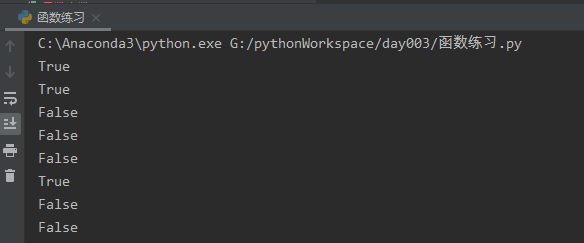一、函数
1.1 函数的定义
1 def hello(): 2 print('hello') 3 print('fdsfjslkfs') 4 5 #函数不调用就不会执行 6 hello() 7 8 def write_file(file_name,content):#形参,形式参数 9 with open(file_name,'w',encoding='utf-8') as f: 10 f.write(content) 11 12 13 write_file('函数.txt','fdsfslfre分倒是累计额老人家')#实参 14 15 #函数返回值 16 #函数没有写返回值时,默认返回None 17 #return: 18 #1、返回数据 19 #2、函数里只要遇到return 函数立马执行结束 20 def read_file(file_name): 21 with open(file_name,'r',encoding='utf-8') as f: 22 content = f.read() 23 return content 24 25 content = read_file('函数.txt') 26 print(content)
1.2 函数的参数
1 def a():#无参数 2 pass 3 4 def b(name,age):#必填参数,位置参数 5 pass 6 7 #默认值参数在调用函数时,如果传了参数值,则使用参数值,如果未传参数值,则用默认的参数值 8 def op_file(file_name,content=None):#默认值参数 9 with open(file_name,'a+',encoding='utf-8') as f: 10 if content: 11 f.write(str(content)) 12 else: 13 f.seek(0) 14 result = f.read() 15 return result 16 17 #可变参数 18 #1、这个是不是必须传的 19 #非必传 20 #2、限制不限制参数的个数 21 #不限个数 22 #3、args 23 #元组 24 def send_sms(*args): 25 print(type(args)) 26 print(args) 27 28 send_sms() 29 #send_sms('198','159') 30 send_sms('198','159','123','234','432','4342','098','198','159','123','234','432','4342','098') 31 32 33 #关键字参数 34 def test(**kwargs):#传入必须得指定关键字,kwargs是字典 35 print(kwargs) 36 print(type(kwargs)) 37 38 test(name='xiaolin',age=19,sex='男') 39 40 #如果四种参数一起用的话,顺序必须是:必填参数,默认值,可变参数,关键字参数 41 #必填参数必须写到默认值参数前面 42 #默认参数必须在可变参数前面 43 #可变参数必须在关键字参数 44 def test2(name,content=None,*args,**kwargs): 45 print(name) 46 print(content) 47 print(args) 48 print(kwargs) 49 50 51 def test3(name,phone,qq,addr,sex): 52 print(name) 53 print(phone) 54 print(qq) 55 print(addr) 56 print(sex) 57 58 59 test3('186','xiaolin','34334','beijing','女')#根据定义的参数顺序来传参 60 test3(phone='123',name='fdsf',qq='re4343',sex='男',addr='guangzhou')#指定参数名字来传参,跟参数位置无关 61 test3('cj001','185134',sex='男',addr='guangzhou',qq='r90343')#组合传参 62 #test3('cj001','185134',sex='男',addr='guangzhou','r90343')#错误,不能这么写
1.3 函数小练习
1 #判断传入参数是否为float类型 2 #1、传参 3 #2、把入参转成字符串 4 #3、判断小数点个数是否为1 5 #4、判断小数点前面的是否为整数 6 #5、判断小数后面是否为整数 7 def is_float(s): 8 boolean = False 9 s = str(s) 10 if s.count('.') == 1: 11 left,right = s.split('.')#根据小数点进行分割 12 if right.isdigit() and left.isdigit() and (int(left) != 0 or int(right) != 0):#左边和右边都是小数 13 boolean = True 14 if left.startswith('-') and left.count('-') == 1: 15 num = left[1:] 16 if num.isdigit() and right.isdigit() and (int(num) != 0 or int(right) != 0): 17 boolean = True 18 return boolean 19 20 21 print(is_float(0.12)) 22 print(is_float(1.12)) 23 print(is_float(1)) 24 print(is_float('sss.0001')) 25 print(is_float('sss.ssss')) 26 print(is_float(-1.23)) 27 print(is_float('0.0')) 28 print(is_float('-0.0'))
执行结果如图所示:

二、json操作
json就是一串字符串,如果在操作json时要获取值很难,将json转成字典就很好操作了
1 import json 2 #python的数据类型和json互相转换 3 #json就是一串字符串 4 d = {'key1':'v1','k2':'v2','k3':'v3','name':'刘婕'} 5 json_str = json.dumps(d,indent=4,ensure_ascii=False)#字典转成字符串,转成json了 6 print(json_str) 7 8 #json.dump()将字典转成json,并写入文件中 9 with open('u2.txt','w',encoding='utf-8') as f: 10 json.dump(d,f,indent=4,ensure_ascii=False)#indent 缩进,ensure_ascii=False 如果是中文就直接显示中文了
1 import json 2 json_str = ''' 3 { 4 "key1": "v1", 5 "k2": "v2", 6 "k3": "v3", 7 "name": "刘婕" 8 } 9 ''' 10 dic = json.loads(json_str)#json字符串转字典 11 print(dic) 12 13 #如果json不合法,就会报错 14 #比如json中有单引号 15 json_str1 = ''' 16 { 17 'key1': "v1", 18 "k2": "v2", 19 "k3": "v3", 20 "name": "刘婕" 21 } 22 ''' 23 dic1 = json.loads(json_str1)#会报错,报json格式不对 24 print(dic1) 25 26 with open('users.txt') as f: 27 result = json.load(f) #先读取文件内容,再将json转成字典 28 print(result)
报错如图所示:

要查看json字符串格式是否正确,可以在下面网站进行查看
